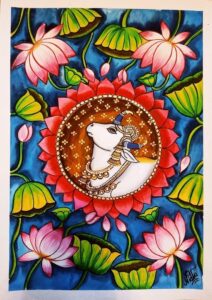The word “Pattachitra” is derived from two Sanskrit words: “patta” meaning cloth, and “Chitra” meaning picture or painting. Pattachitra art involves intricate paintings on cloth, usually using natural colors and pigments.
The Pattachitra paintings are known for their vibrant colors, intricate details, and the use of traditional motifs and themes. The artists who create Pattachitra paintings are called “chitrakars,” and the art form has been passed down through generations within certain families or communities.
The process of creating Pattachitra art is meticulous and time-consuming. It typically starts with treating a piece of cloth, often cotton or silk, with a mixture of chalk and gum to make it stiff and suitable for painting. The outline of the painting is then drawn using a brush or a piece of cloth dipped in a black pigment made from lamp soot mixed with water.
Once the outline is complete, the colors are applied to the painting. Traditionally, the artists used natural pigments made from minerals, stones, shells, and flowers. These pigments were ground and mixed with water or natural binders to create the desired colors. Nowadays, artists also use synthetic pigments to achieve a wider range of hues.
The themes of Pattachitra paintings often revolve around mythology, folklore, and religious stories. Common subjects include depictions of Hindu gods and goddesses, scenes from the epics like the Ramayana and Mahabharata, and local folk tales. The paintings are filled with intricate details, ornamental designs, and decorative borders.
Pattachitra art is not limited to paintings on cloth. It has also expanded to other art forms, such as painted masks, palm leaf engravings, and painted wooden toys. These creations often exhibit the same style and motifs as the traditional Pattachitra paintings.

Chitrakars are the traditional names for the painters. The place where a patta painter keeps his workshop is where his entire family resides. The glue, canvas, and colors—what we refer to as the fill-in—are all prepared by female members, who also apply the final lacquer covering. The initial line is drawn by the master hand, who is typically a male member, and the finishing touches are applied. Patta paintings are created on tiny cotton fabric strips. The clothes is covered in a mixture of chalk and gum derived from guar or tamarind seeds to prepare the canvas. The cloth is then dried after being rub with the aid of two separate stones. Gum and chalk mixed together give the cloth’s surface a leathery feel, which the painters use to paint on.
Today, Pattachitra art has gained recognition both nationally and internationally. It is not only appreciated for its cultural significance but also valued as a unique and beautiful art form. The artisans continue to preserve and promote this traditional art, ensuring its legacy for future generations.

